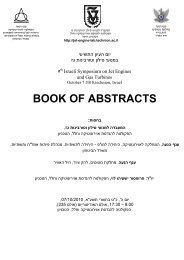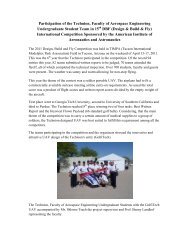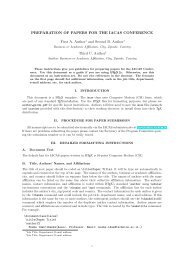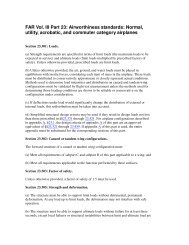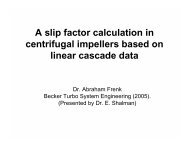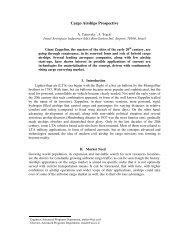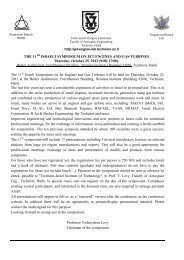A Century of Ramjet Propulsion Technology Evolution - Faculty of ...
A Century of Ramjet Propulsion Technology Evolution - Faculty of ...
A Century of Ramjet Propulsion Technology Evolution - Faculty of ...
Create successful ePaper yourself
Turn your PDF publications into a flip-book with our unique Google optimized e-Paper software.
54 FRY<br />
Fig. 37 France JAPHAR fixed dual-mode scramjet engine geometry<br />
(1997–2002).<br />
Fig. 38 Russian Igla second generation HFL (1999–today).<br />
that one or more <strong>of</strong> the technologies may be incorporated in vehicles<br />
designed for Mach > 6 flight.<br />
France began the development <strong>of</strong> JAPHAR in 1997 in cooperation<br />
with Germany as a follow-on to the PREPHA (French)<br />
and Sänger (German) programs to pursue hypersonic airbreathing<br />
propulsion research for reusable space launcher applications. 80<br />
Studies were organized around a waverider concept vehicle with a<br />
flight Mach between 4 and 8. JAPHAR employs a fixed-geometry<br />
dual-mode scramjet engine design (Fig. 37) developed based on previous<br />
hydrogen-fueled PREPHA work. Basic objectives included<br />
improvement and validation <strong>of</strong> numerical codes for aerothermodynamics<br />
and defining a flight-test vehicle. 72 Component hardware<br />
(4 × 4 in. entrance) testing was conducted from 2000 to 2002 simulating<br />
flight Mach numbers <strong>of</strong> 4.9, 5.8, and 7.6. French–German<br />
cooperation formally ended in 2001.<br />
In 1997, the DARPA initiated a program to develop ARRMD,<br />
as a low cost, air-launched Mach 4–8 missile. The program initially<br />
considered two hydrocarbon-fueled propulsion designs: the<br />
HyTech waverider two-dimensional engine and the axisymmetric<br />
DCR technology multiple-forward inlets. Both were potentially to<br />
make use <strong>of</strong> active cooling and a tandem solid propellant booster.<br />
The DCR engine was the design selected. Although the program<br />
was terminated in 2001 the DCR technology is being developed<br />
under the U.S. HyFly program, whereas the HyTech technology is<br />
being incorporated into the SED program.<br />
One <strong>of</strong> the Russian second generation flying laboratories was<br />
developed under the Igla (Fig. 38) program. 65 The first flight test<br />
was conducted in mid-1999, and a dummy Igla airborne testbed<br />
was displayed at the Russian Moscow airshow (MAKS) 1999 air<br />
show. The waverider vehicle is designed to achieve Mach 5–14 at<br />
an altitude <strong>of</strong> 82,000–164,000 ft. The Igla is boosted to supersonic<br />
speeds by the Rokot system; on separation, the flying testbed is<br />
injected into an operational trajectory for the scramjet engine, and<br />
the test vehicle is recovered by parachute. The testbed employs<br />
regeneratively cooled scramjet engine modules previously tested<br />
in ground-based facilities. Funding will dictate the future <strong>of</strong> this<br />
activity.<br />
The U.S. Navy has supported development <strong>of</strong> ATR technology<br />
under the Integrated High Performance Turbine Engine <strong>Technology</strong><br />
(IHPTET) program for potential application to air-launched Mach<br />
5 missiles since 1999. Engine development is focusing on the liquid<br />
air cycle engine turboramjet (ACETR) cycle with the purpose <strong>of</strong> re-<br />
ducing engine size and weight while maintaining theoretical performance.<br />
Although this engine cycle is immature and more complex<br />
when compared to alternative ramjet cycles, such an engine can<br />
provide increased loitering capability. Applications could include<br />
high-speed Tomahawk or other strike missile.<br />
The United States is investigating turbine-based propulsion systems<br />
for access to space under the revolutionary turbine accelerator<br />
(RTA)/TBCC project as part <strong>of</strong> the Next Generation Launch Technologies<br />
(NGLT) activities. 81 Present turbine propulsion systems<br />
can propel vehicles to Mach 3. These current systems are costly,<br />
require high maintenance, and have low durability. Near-term development<br />
goals <strong>of</strong> RTA will concentrate on turbine accelerators that<br />
will reach at least Mach 4 and provide dramatic increases in maintainability<br />
and operability through the use <strong>of</strong> advanced technologies.<br />
Studies suggest that the use <strong>of</strong> turbine propulsion can provide the potential<br />
for aircraftlike, space flight operations that may significantly<br />
reduce launch costs and improve safety. 82 During the initial phase <strong>of</strong><br />
RTA/TBCC, NASA GRC and general electric (GE) are designing a<br />
ground demonstrator engine for validation testing in fiscal year (FY)<br />
2006. The demonstrator is a turb<strong>of</strong>an ramjet, designed to transition<br />
from an augmented turb<strong>of</strong>an to a ramjet that produces the thrust required<br />
to accelerate the NGLT vehicle to Mach 4+. The initial flight<br />
test vehicle RTA-1 will demonstrate the basic TBCC concept <strong>of</strong> using<br />
a conventional turb<strong>of</strong>an to accelerate an access-to-space vehicle<br />
to Mach 3 and then transition to a ramjet mode designed to boost<br />
the vehicle to Mach 4+. Included in the testing is demonstration <strong>of</strong><br />
full-scale RTA enabling technologies along with reliability and durability<br />
<strong>of</strong> high-Mach turbine components, fuel, and control systems.<br />
In 2009, a second flight demonstrator RTA-2 will feature hardware<br />
at the scale <strong>of</strong> the vision propulsion system (VPS) product engine.<br />
RTA-2 combines the technology being developed in RTA-1 with<br />
advanced features from the DOD IHPTET and versatile affordable<br />
and advanced turbine engine (VAATE) programs and from NASA’s<br />
ultra efficient engine technology (UEET) program to meet the VPS<br />
goals <strong>of</strong> thrust to weight ratio, specific fuel consumption, specific<br />
impulse, safety, and cost. Together, initial and potential final configurations<br />
for RTA-1 and RTA-2 are expected to provide a technology<br />
readiness level-6 confidence in the key technology features needed<br />
to achieve the goals <strong>of</strong> the VPS. The program is also designed to<br />
meet the aggressive safety, cost, maintainability, and performance<br />
goals for the third generation RLV concept established by NASA. 81<br />
The French Promethée project, initiated in 1999, was aimed at<br />
developing fully variable-geometry endothermic hydrocarbon fuel<br />
dual-mode ramjet technology for military applications. The design<br />
is a generic air-to-surface missile able to fly at speeds <strong>of</strong> Mach 2–8<br />
and altitudes up to 130,000 ft. A full-scale combustion chamber<br />
was tested at simulated flight conditions <strong>of</strong> Mach 2–7.5. Under the<br />
original program, air-launched flight tests were planned at speeds <strong>of</strong><br />
Mach 4, 6, and 8 between 2009–2012. The flight-test vehicle was to<br />
be nonrecoverable. 49 The Promethée project was started by France<br />
to acquire first-hand knowledge <strong>of</strong> hydrocarbon-fueled dual-mode<br />
ramjet technology for military applications. 72 The program includes<br />
system studies and definition <strong>of</strong> a generic vehicle, design and optimization<br />
<strong>of</strong> a combustion chamber, and ground demonstration leading<br />
to flight validation. The French technology development has now<br />
progressed from direct-connect testing under the Promethée program<br />
to semifreejet and freejet testing in support <strong>of</strong> a new flight-test<br />
program called LEA initiated in 2003 and expected to run to 2012.<br />
India is conducting research and development activities for aerobic<br />
vehicle for advanced trans-atmospheric research (AVATAR),<br />
a reusable aerospace plane that is expected to be a 20-ton vehicle<br />
capable <strong>of</strong> 1000–2000 lbm payloads to low Earth orbit. A 3-ton<br />
subscale demonstrator vehicle AVATAR-M is under development.<br />
Scramjet Development: 2000-Today<br />
Scramjet technology developments are underway in many countries<br />
to capitalize on significant pay<strong>of</strong>fs that hypersonic speed and<br />
long range can provide. Table 6 also summarizes ramjet evolution<br />
in the era from 2000 to today and provides originating country,<br />
engine/vehicle names, development dates, performance, physical<br />
characteristics, and state <strong>of</strong> development.






